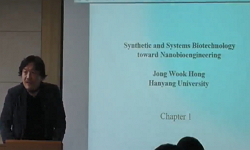목적: 결핵성 림프절염은 가장 흔한 폐외결핵질환 중의 하나이다. 진단은 임상소견 및 림프절 생검을 통한 항산성 도말염색, 결핵균 배양, 병리소견등으로 이루어지나 이들의 민감도가 낮아...
http://chineseinput.net/에서 pinyin(병음)방식으로 중국어를 변환할 수 있습니다.
변환된 중국어를 복사하여 사용하시면 됩니다.
- 中文 을 입력하시려면 zhongwen을 입력하시고 space를누르시면됩니다.
- 北京 을 입력하시려면 beijing을 입력하시고 space를 누르시면 됩니다.
중합효소연쇄반응을 이용한 결핵성 림프절염의 진단 = Diagnosis of Tuberculous Lymphadenitis by Polymerase Chain Reaction
한글로보기https://www.riss.kr/link?id=A2037298
- 저자
- 발행기관
- 학술지명
- 권호사항
-
발행연도
1997
-
작성언어
Korean
- 주제어
-
KDC
513.90
-
자료형태
학술저널
- 발행기관 URL
-
수록면
219-224(6쪽)
- 제공처
- 소장기관
-
0
상세조회 -
0
다운로드
부가정보
국문 초록 (Abstract)
방법: 경부종물을 주소로 내원한 환자중 결핵성림프절염이 의심되었던 환자 50여명과 대조군으로 결핵성 림프절염이 배제되었던 10명을 대상으로 하였다. 림프절 세침흡인을 시행하여 검체를 얻었으며, phenol/chloroform법으로 DNA를 분리하였다. 그 다음 IS6110에 대한 시발체를 이용해 중합효소연쇄반응을 시행하였으며, 증폭산물은 겔 전기영동하에서 Ethidium bromide로 염색하여 관찰하였다.
결과: 임상적으로 결핵성 림프절염이 의심되었던 환자 50명중 45명에서 양성으로 나타났으며, 결핵성림프절염이 배제되었던 10명의 대조군중 1명에서 양성으로 나타났다. 따라서 중합효소연쇄반응의 민감도는 90%, 특이도도 90%로 나타났다.
중합효소연쇄반응의 검사 민감도는 결핵균 DNA 10fg까지 검출할 수 있었으며 이는 결핵균 약 2개에 해당하는 양이다.
결론: 림프절 세침흡인검체로 시행한 중합효소연쇄반응은 결핵성 림프절염의 진단에 매우 유용하게 이용될 수 있으리라 생각된다.
목적: 결핵성 림프절염은 가장 흔한 폐외결핵질환 중의 하나이다. 진단은 임상소견 및 림프절 생검을 통한 항산성 도말염색, 결핵균 배양, 병리소견등으로 이루어지나 이들의 민감도가 낮아 진단에 어려움이 있다. 이에 저자는 림프절 세침흡인 검체를 이용해 중합효소연쇄반응을 시행하여, 결핵성 림프절염의 진단에 대한 이의 유용성을 평가해 보고자 하였다.
방법: 경부종물을 주소로 내원한 환자중 결핵성림프절염이 의심되었던 환자 50여명과 대조군으로 결핵성 림프절염이 배제되었던 10명을 대상으로 하였다. 림프절 세침흡인을 시행하여 검체를 얻었으며, phenol/chloroform법으로 DNA를 분리하였다. 그 다음 IS6110에 대한 시발체를 이용해 중합효소연쇄반응을 시행하였으며, 증폭산물은 겔 전기영동하에서 Ethidium bromide로 염색하여 관찰하였다.
결과: 임상적으로 결핵성 림프절염이 의심되었던 환자 50명중 45명에서 양성으로 나타났으며, 결핵성림프절염이 배제되었던 10명의 대조군중 1명에서 양성으로 나타났다. 따라서 중합효소연쇄반응의 민감도는 90%, 특이도도 90%로 나타났다.
중합효소연쇄반응의 검사 민감도는 결핵균 DNA 10fg까지 검출할 수 있었으며 이는 결핵균 약 2개에 해당하는 양이다.
결론: 림프절 세침흡인검체로 시행한 중합효소연쇄반응은 결핵성 림프절염의 진단에 매우 유용하게 이용될 수 있으리라 생각된다.
다국어 초록 (Multilingual Abstract)
We evaluate the sensitivity and specificity of the polymerase chain reaction assay for the rapid diagnosis of tuberculous lymphadenitis.
Methods: the study included 50 patient with clinically suspected tuberculous lymphadenitis. We performed fine needle aspiration biopsies(FNAB) on head and neck lymph node. The DNA of the sample was purified by phenol/chloroform method. The nested PCR was performed with TB-CR kit(Bioneer, Korea), which a amplified a insertion sequence IS 6110 sequences. The PCR product was analysed by agarose gel electrophoresis in the presence of ethidium bromide.
Results: Forty-five of the 50 clinically suspected specimens were PCR-positive, 5 specimens were negative. And one of the 10 negative specimens was positive. The sensitivity and specificity of the PCR was 90% and 90%, respectively.
Conclusion: The polymerase chain reaction is a very sensitive and rapid method for rapid detection of M. tuberculosis in patient with tuberculous lymphadenitis.
Background: Tuberculous lymphadenitis is the commonest form of extrapulmonary tuberculosis. The laboratory diagnosis of tuberculous lymphadenitis is based on the traditional method of the acid-fast stain and culture of discharge or lymph node. However...
Background: Tuberculous lymphadenitis is the commonest form of extrapulmonary tuberculosis. The laboratory diagnosis of tuberculous lymphadenitis is based on the traditional method of the acid-fast stain and culture of discharge or lymph node. However, acid-fast strain lack sensitivity and specificity, and culture is time-consuming. Polymerase chain reaction is a rapid, sensitive and specific DNA amplification technique for the detection of Mycobacterium tuberculosis in sputum, pleural fluid, cerebrospinal fluid, or others.
We evaluate the sensitivity and specificity of the polymerase chain reaction assay for the rapid diagnosis of tuberculous lymphadenitis.
Methods: the study included 50 patient with clinically suspected tuberculous lymphadenitis. We performed fine needle aspiration biopsies(FNAB) on head and neck lymph node. The DNA of the sample was purified by phenol/chloroform method. The nested PCR was performed with TB-CR kit(Bioneer, Korea), which a amplified a insertion sequence IS 6110 sequences. The PCR product was analysed by agarose gel electrophoresis in the presence of ethidium bromide.
Results: Forty-five of the 50 clinically suspected specimens were PCR-positive, 5 specimens were negative. And one of the 10 negative specimens was positive. The sensitivity and specificity of the PCR was 90% and 90%, respectively.
Conclusion: The polymerase chain reaction is a very sensitive and rapid method for rapid detection of M. tuberculosis in patient with tuberculous lymphadenitis.
동일학술지(권/호) 다른 논문
-
Pasteurella hemolytica에 의한 농흉 1예
- 대한감염학회
- 염호기
- 1997
-
- 대한감염학회
- 김능수
- 1997
-
- 대한감염학회
- 신종희
- 1997
-
Curvularia species에 의해 발톱에 발생된 조갑진균증 1예
- 대한감염학회
- 손향은
- 1997




 RISS
RISS



